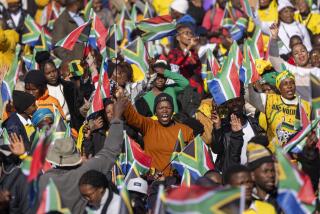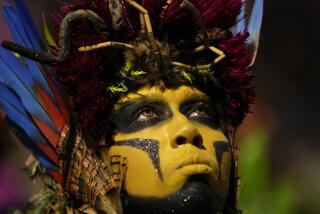Strikers Test 3 Big S. African Firms
JOHANNESBURG, South Africa — A major test of strength between the all-black National Union of Mineworkers and three of South Africa’s most powerful corporations spread through nine gold and coal mines Monday.
Sporadic violence was reported at several of the mines, with the union accusing owners and the police of using severe levels of force against the striking miners in clashes that could bring a sharp escalation of South Africa’s continuing racial strife.
National police headquarters in Pretoria said seven union members were arrested Monday by mine security forces on charges of intimidating other miners in an effort to try to keep them from reporting for work at the West Driefontein Gold Mine at Carltonville, about 70 miles west of Johannesburg. Two union organizers were arrested at the Deelkraal Gold Mine nearby, also on charges of intimidation.
According to the union, 83 of its shaft stewards and strike committee members were seized.
More Township Rioting
Meanwhile, renewed rioting broke out in Colored (mixed-race) townships around Cape Town and in the black townships outside Durban. These were the scenes last month of some of the worst strife of the last year.
Police said that overnight Sunday, three blacks, one of them a policeman, were killed in separate parts of the country, and unconfirmed reports late Monday from Cape Town said two people, both Coloreds, had died in clashes with the police there.
As the miners’ strike began over the weekend, tear gas and rubber bullets were used at three pits to break up union meetings and to disperse groups trying to prevent miners from going to work, according to management statements.
The mine owners said that the situation at most of the struck mines was peaceful. But spokesmen acknowledged late in the day that riot police were standing by in force at virtually all the mines.
The union said 28,000 workers out of 77,500 at the targeted five gold mines and two coal mines were out on strike but that “alarming proportions of intimidation by mine management” had limited the numbers who observed picket lines at several pits.
Labor’s observance of the strike, according to management spokesmen, ranged downward from 85% of the work force at some locations to almost zero at several others.
In addition, two other gold mines, not originally targeted by the union but owned by one of the companies involved, were struck by members unhappy with pay increases they had received.
A showdown between the union and the companies may come today when Gold Fields of South Africa Ltd. and General Mining Union Corp. Ltd., known as Gencor, begin firing strikers, an action permitted under South African labor law.
Wider Walkout Threatened
Cyril Ramaphosa, the union president, has threatened a strike at all mines if owners try to halt the strike forcibly. On Monday, the United Democratic Front anti-apartheid coalition pledged support.
Gold Fields and Gencor, along with Anglovaal Ltd., the third company, have vowed to hold to pay raises to a range of 14% to 19%, which they unilaterally granted the miners in July. They are refusing to yield to demands that they match 19% to 22% raises agreed to last month by other mining companies.
The companies concede that the issue also involves the balance of power between owners and the union, which claims 240,000 members among 550,000 black South African miners in the nation’s largest export-earning industry.
The black miners are paid an average of $157 per month, plus food and housing, compared to an average of $900 paid to white miners. Despite this disparity, they are among the highest-paid black workers in all Africa.
Despite the strike, the South African rand surged forward and most stock prices rose Monday when the Johannesburg Stock Exchange and foreign-currency markets reopened under new government regulations.
The new rules aim to prevent the outflow of capital by delaying for four months the repayment of the principal on almost all foreign debts and penalizing foreign investors seeking to pull out of the country.
The rand, which was worth 35.5 U.S. cents after a sharp drop last Tuesday, traded at around 45 cents most of the day, but only with strong support by South Africa’s Reserve Bank.
The most serious unrest Monday was reported from Cape Town, where police fought running battles during the day with Colored youths angered by harsh action last week against an attempted march to Pollsmoor prison.
Skirmishes were fought in virtually every Colored township around the city as youths boycotted classes, stoned passing cars, set fire to delivery vehicles, schools and government offices and erected burning barricades.
In Durban, new clashes were reported in Umlazi, a black township that was at the center of riots in which more than 70 died last month, and at Inanda, a mixed Indian and black community where Asian merchants and residents were burned out by black gangs.
More to Read
Sign up for Essential California
The most important California stories and recommendations in your inbox every morning.
You may occasionally receive promotional content from the Los Angeles Times.










